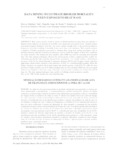Por favor, use este identificador para citar o enlazar este ítem:
http://www.alice.cnptia.embrapa.br/alice/handle/doc/5708Registro completo de metadatos
| Campo DC | Valor | Lengua/Idioma |
|---|---|---|
| dc.contributor.author | VALE, M. M. | pt_BR |
| dc.contributor.author | MOURA, D. J. de | pt_BR |
| dc.contributor.author | NÄÄS, I. de A. | pt_BR |
| dc.contributor.author | OLIVEIRA, S. R. de M. | pt_BR |
| dc.contributor.author | RODRIGUES, L. H. A. | pt_BR |
| dc.date.accessioned | 2017-04-11T15:52:42Z | - |
| dc.date.available | 2017-04-11T15:52:42Z | - |
| dc.date.created | 2008-12-17 | pt_BR |
| dc.date.issued | 2008 | pt_BR |
| dc.identifier.citation | Scientia Agricola, Piracicaba, v. 65, n. 3, p. 223-229, May/June 2008. | pt_BR |
| dc.identifier.uri | http://www.alice.cnptia.embrapa.br/alice/handle/doc/5708 | pt_BR |
| dc.description | Heat waves usually result in losses of animal production since they are exposed to thermal stress inducing an increase in mortality and consequent economical losses. Animal science and meteorological databases from the last years contain enough data in the poultry production business to allow the modeling of mortality losses due to heat wave incidence. This research analyzes a database of broiler production associated to climatic data, using data mining techniques such as attribute selection and data classification (decision tree) to model the impact of heat wave incidence on broiler mortality. The temperature and humidity index (THI) was used for screening environmental data. The data mining techniques allowed the development of three comprehensible models for estimating specifically high mortality during broiler production. Two models yielded a classification accuracy of 89.3% by using Principal Component Analysis (PCA) and Wrapper feature selection approaches. Both models obtained a class precision of 0.83 for classifying high mortality. When the feature selection was made by the domain experts, the model accuracy reached 85.7%, while the class precision of high mortality was 0.76. Meteorological data and the calculated THI from meteorological stations were helpful to select the range of harmful environmental conditions for broilers 29 and 42 days old. The data mining techniques were useful for building animal production models. | pt_BR |
| dc.language.iso | eng | eng |
| dc.rights | openAccess | eng |
| dc.subject | ITU | pt_BR |
| dc.subject | Dados ambientais | pt_BR |
| dc.subject | Mineração de dados | pt_BR |
| dc.subject | Agropecuária | pt_BR |
| dc.subject | Data mining | pt_BR |
| dc.title | Data mining to estimate broiler mortality when exposed to heat wave. | pt_BR |
| dc.type | Artigo de periódico | pt_BR |
| dc.date.updated | 2017-04-11T15:52:42Z | pt_BR |
| dc.subject.thesagro | Frango de Corte | pt_BR |
| riaa.ainfo.id | 5708 | pt_BR |
| riaa.ainfo.lastupdate | 2017-04-11 | pt_BR |
| dc.identifier.doi | http://dx.doi.org/10.1590/S0103-90162008000300001 | pt_BR |
| dc.contributor.institution | MARCOS MARTINEZ VALE, FEAGRI/UNICAMP; DANIELLA JORGE DE MOURA, FEAGRI/UNICAMP; IRENILZA DE ALENCAR NÄÄS, FEAGRI/UNICAMP; STANLEY ROBSON DE MEDEIROS OLIVEIRA, CNPTIA; LUIZ HENRIQUE ANTUNES RODRIGUES, FEAGRI/UNICAMP. | pt_BR |
| Aparece en las colecciones: | Artigo em periódico indexado (CNPTIA)  | |
Ficheros en este ítem:
| Fichero | Descripción | Tamaño | Formato | |
|---|---|---|---|---|
| APdataminingValeetal2008.pdf | 197,55 kB | Adobe PDF |  Visualizar/Abrir |









